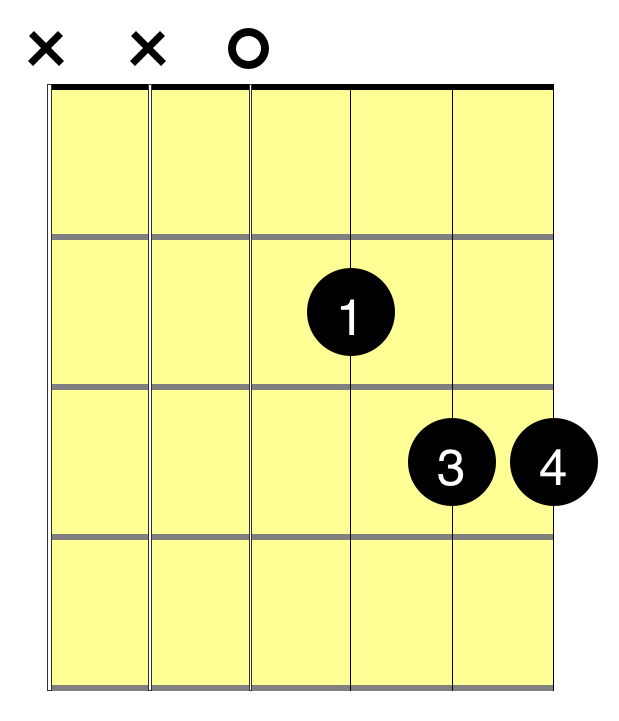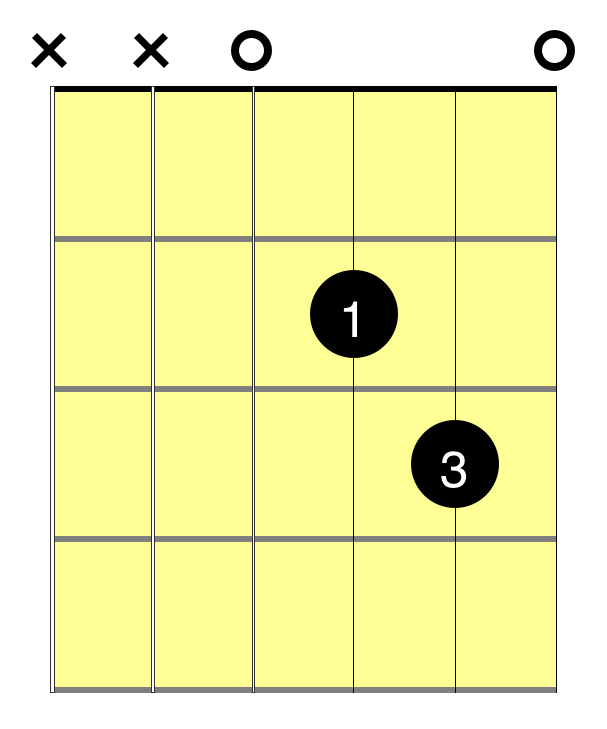Ah, the open D chord. A true classic, featured in about eight gazillion rock and pop songs. One of the things that makes this chord fun to play is that it’s easy to play a couple of variations by adding or removing fingers. More on that below; first, let’s learn how to play this thing.
D Chord: Standard Fingering
As shown here, when played in open position, the D major chord is played with the 1st and 3rd fingers both on the second fret, and with the 3rd finger on the third fret. Remember to keep your thumb behind the neck in the correct position. (See this lesson on the Em chord to learn the basic hand position for all chords.)
As usual, you should play the notes with the tips of your fingers to avoid any buzzing or muting of notes. Also, try to keep your fingertips fairly close together instead of spreading them out across the E and B strings. The next photo shows an example of what I mean.
Compare the spacing of the fingers in this photo with the one above. Notice how the 1st finger (playing the second fret of the G string) is far away from the second fret. It’s actually closer to the first fret. You generally want to avoid this kind of finger placement because it’s much more likely to result in buzzing (due to the fact that there is so much space between the finger and the point where the string crosses over the fret). Whenever possible, you want to play close to the fret, like the way the 2nd finger is playing close to the second fret on the E string here.
Variations on the D Chord
Now that you know how to play this chord in open position, if you’re feeling ambitious, we can take a look at two common variations that add just a little bit of mojo to the regular version of the chord. (Or you can just focus on the D chord for now and come back to these variations later.) Technically, these aren’t really variations—they’re different chords—but they’re often used as embellishments for the D major chord when it’s played in the open position as shown above.
D Suspended 4th (Dsus4)
This chord (pronounced “D suss four”) gets its name from the fact that you take the 3rd note of the D major scale and raise it up to the 4th note instead. Explaining this any more requires some discussion of music theory, so I’ll skip that for now. But the important point is that the fingering changes slightly—you add your pinky to the 3rd fret of the first string, like so:
Notice (in the photo on the right) that the 2nd finger stays where it is on the second fret; you don’t lift it up off the fretboard. So in other words, you keep playing the D chord and you just add the 4th finger (pinky) in front of the 2nd finger. This way, you can easily add or remove it to alter the regular chord.
D Suspended 2nd (Dsus2)
This chord (pronounced “D suss two”), is just a D major chord with the 2nd finger lifted up off the fretboard:
Mixing it Up
So now that you’ve learned the D chord and two different variations, let’s see how they’re used.
As I mentioned above, it’s very common to embellish the D chord by adding the pinky or removing the 2nd finger (making the Dsus4 and Dsus2, respectively). For example, here’s a little snippet from “Stairway to Heaven” that shows this:
As you can see in this clip, the 1st and 3rd fingers stay put on the fretboard while the middle finger and pinky move on and off to form the different chords. After you’ve gotten the D major chord down, try playing around with these variations to see how they feel (and sound).
Well that about wraps it up for the D chord. As you might already know, there are plenty of other ways to play a D chord on the guitar, in different locations on the neck. But this is the basic open chord that you want to learn first so you can whip it out around the campfire and strum along with any song under the sun. Well…you’ll need to learn some other chords too, but this is an important one to have in your arsenal early on. Good luck and keep practicing.







